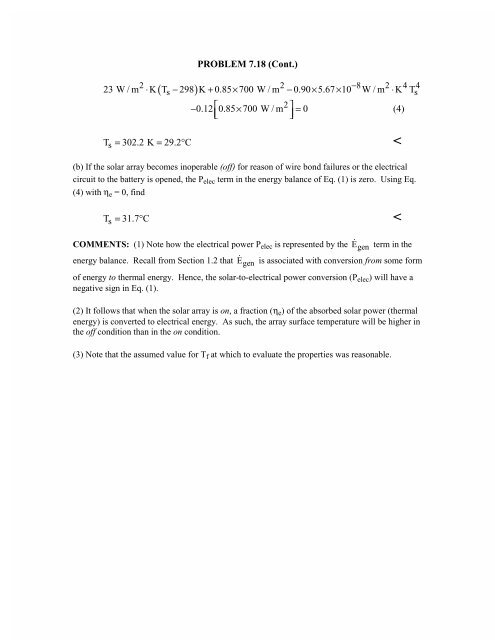HW Chapter 7
HW Chapter 7
HW Chapter 7
You also want an ePaper? Increase the reach of your titles
YUMPU automatically turns print PDFs into web optimized ePapers that Google loves.
PROBLEM 7.18 (Cont.)<br />
23 W / m<br />
2<br />
⋅K 2 8 2 4 4<br />
( Ts<br />
− 298)<br />
K + 0.85× 700 W / m − 0.90× 5.67× 10<br />
−<br />
W / m ⋅K Ts<br />
− 0.12 ⎡0.85 700 W / m<br />
2 ⎤<br />
⎢<br />
×<br />
⎥<br />
= 0<br />
(4)<br />
⎣<br />
⎦<br />
Ts<br />
= 302.2 K = 29.2° C<br />
<<br />
(b) If the solar array becomes inoperable (off) for reason of wire bond failures or the electrical<br />
circuit to the battery is opened, the P elec term in the energy balance of Eq. (1) is zero. Using Eq.<br />
(4) with η e = 0, find<br />
Ts<br />
= 31.7° C<br />
<<br />
COMMENTS: (1) Note how the electrical power P elec is represented by the E gen term in the<br />
energy balance. Recall from Section 1.2 that E gen is associated with conversion from some form<br />
of energy to thermal energy. Hence, the solar-to-electrical power conversion (P elec ) will have a<br />
negative sign in Eq. (1).<br />
(2) It follows that when the solar array is on, a fraction (η e ) of the absorbed solar power (thermal<br />
energy) is converted to electrical energy. As such, the array surface temperature will be higher in<br />
the off condition than in the on condition.<br />
(3) Note that the assumed value for T f at which to evaluate the properties was reasonable.

















